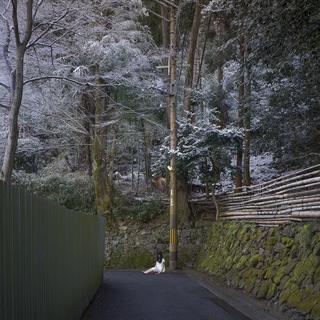


Photographer Pierre-Elie de Pibrac's Japan, an archipelago of darkness
In picturesTo capture a vulnerable and marginal Japan, the photographer spent several months in Kyoto to acclimatize and break down barriers with a people reluctant to open up. His series is being exhibited at the Musée Guimet until January 15.
Under the title Hakanai Sonzai, which can be translated as "to feel oneself an ephemeral creature," photographer and visual artist Pierre-Elie de Pibrac has brought together the destinies of Japanese people on the margins. This series is the second stage in his trilogy on resilience, which began in Cuba with sugarcane farmers and is due to continue in Israel. In this work, exhibited at the Musée Guimet until January 15, he said he "is telling the story of individuals seeking to understand their identity in the face of the weight of society's rules."
The images were shot between December 2019 and August 2020. Attracted by this archipelago where "nature has imposed its law to define the culture of preciousness and control," the 30-year-old Frenchman settled with his family in a traditional house next to the Silver Pavilion in Kyoto, and the Philosophy Road that leads to it. In this typical setting, he read, watched films and took Japanese lessons. "I didn't photograph anything for the first two months. It was hard for me to understand, to get into the nature-culture link," he said.
Then the vagueness dissipated. In Kyoto, in the northern mining town of Yubari, and in Motoyama (to the west, on the island of Shikoku), de Pibrac met with yakuzas, hikikomori (who can no longer leave their homes), johatsu (the "evaporated," or voluntarily disappeared) and survivors of the 2011 Fukushima disaster. He gave some of them disposable cameras and notebooks to encourage them to confide in him.
A long pause
"In this country, where the locals don't open up much, I had to be very patient to break the ice and gently enter the lives of those whose stories I wanted to tell." Based on these notes and photos, the photographer, assisted by his wife, Olivia, recreated a key moment in the lives of Japanese people photographed in places emptied of tourists by the Covid-19 pandemic.
De Pibrac takes all his shots with a photographic chamber (a very large-format camera): "What I like is not to create a snapshot, but a photo like a performance that tells a story." The technique requires a long pause. "People are impressed by the chamber but end up making it their own. They enter this world and know that it's a pivotal moment in their lives." He alternates between color and black and white, portraits and landscapes.
"Color is important because it is reality, and people need to be photographed in reality. Black and white reveals the power of nature or the way it reappropriates human presence." The black-and-white shots of a house in the snow, lotus flowers or a staircase lost in a cypress forest are inspired by the technique of ukiyo-e prints, those "images of the floating world" born during the Edo period (1603-1868). The photographer had them printed on mulberry paper by a Kyoto craftsman, "to emphasize the attention to detail."
You have 25% of this article left to read. The rest is for subscribers only.
